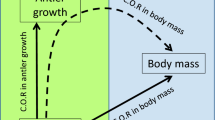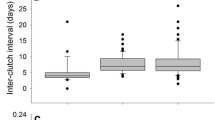Abstract
Organisms should adopt a risk-sensitive reproductive allocation when summer reproductive allocation competes with survival in the coming winter. This trade off is shown through autumn female body mass, which acts as an insurance against unpredictable winter environmental conditions. We tested this hypothesis on female reindeer in a population that has experienced a time period of dramatic increase in abundance. Environmental conditions during winter were fairly stable (with the exception of 1 year). We conclude that increased population abundance (perhaps in interaction with winter environmental conditions) could have represented a worsening of winter environmental conditions as both autumn offspring and spring female body mass decreased during the course of the study. Moreover, we found that the cost of reproduction was related to environmental conditions as: (1) autumn body mass was larger for barren than for lactating females, and this difference was temporally highly variable; (2) lactating females produced smaller offspring than barren ones in the following year; and (3) reproductive output (offspring size) decreased over time. We also found evidence of quality effects as lactating females had a higher reproductive success in the following year. In sum, a worsening of winter conditions lead to: (1) decreased reproductive output; (2) lowered autumn body mass for lactating females; and (3) increased body mass for barren females. Since females reduce their reproductive allocation as winter conditions becomes more severe, we conclude that reindeer have adopted a risk-sensitive reproductive allocation.




Similar content being viewed by others
References
Anderson P (1983) The reproductive role of the human breast. Curr Anthropol 24:25–45
Anonymous (2007) Ressursregnskap for reindriftsnæringen. In. Reindriftsforvaltningen, Alta, Norway
Bårdsen B-J, Fauchald P, Tveraa T, Langeland K, Yoccoz NG, Ims RA (2008) Experimental evidence for a risk sensitive life history allocation in a long-lived mammal. Ecology 89:829–837
Bårdsen B-J, Fauchald P, Tveraa T, Langeland K, Nieminen M (2009) Experimental evidence of cost of lactation in a low risk environment for a long-lived mammal. Oikos 118:837–852
Bates D, Maechler M (2009) lme4: linear mixed-effects models using S4 classes. R package version 0.999375-3
Bolker BM et al (2009) Generalized linear mixed models: a practical guide for ecology and evolution. Trends Ecol Evol 24:127–135
Bronson FH (1995) Seasonal-variation in human-reproduction—environmental-factors. Q Rev Biol 70:141–164
Clutton-Brock TH, Albon SD, Guinness FE (1989) Fitness costs of gestation and lactation in wild mammals. Nature 337:260–262
Clutton-Brock TH, Stevenson IR, Marrow P, MacColl AD, Houston AI, McNamara JM (1996) Population fluctuations, reproductive costs and life-history tactics in female Soay sheep. J Anim Ecol 65:675–689
Coulson T, Milner-Gulland EJ, Clutton-Brock TH (2000) The relative roles of density and climatic variation on population dynamics and fecundity rates in three contrasting ungulate species. Proc R Soc Lond B Biol Sci 267:1771–1779
Coulson T et al (2001) Age, sex, density, winter weather, and population crashes in Soay sheep. Science 292:1528–1531
DelGiudice GD, Riggs MR, Joly P, Pan W (2002) Winter severity, survival, and cause-specific mortality of female white-tailed deer in north-central Minnesota. J Wildl Manage 66:698–717
Dufour DL, Sauther ML (2002) Comparative and evolutionary dimensions of the energetics of human pregnancy and lactation. Am J Hum Biol 14:584–602
Ellison PT (2003) Energetics and reproductive effort. Am J Hum Biol 15:342–351
Fauchald P, Tveraa T, Henaug C, Yoccoz N (2004) Adaptive regulation of body reserves in reindeer, Rangifer tarandus: a feeding experiment. Oikos 107:583–591
Festa-Bianchet M, Gaillard JM, Jorgenson JT (1998) Mass- and density-dependent reproductive success and reproductive costs in a capital breeder. Am Nat 152:367–379
Forchhammer MC, Clutton-Brock TH, Lindström J, Albon SD (2001) Climate and population density induce long-term cohort variation in a northern ungulate. J Anim Ecol 70:721–729
Gaillard JM, Yoccoz NG (2003) Temporal variation in survival of mammals: a case of environmental canalization? Ecology 84:3294–3306
Gaillard JM, Festa-Bianchet M, Yoccoz NG, Loison A, Toïgo C (2000) Temporal variation in fitness components and population dynamics of large herbivores. Annu Rev Ecol Syst 31:367–393
Gittleman JL, Thompson SD (1988) Energy allocation in mammalian reproduction. Am Zool 28:863–875
Hanssen SA, Hasselquist D, Folstad I, Erikstad KE (2005) Cost of reproduction in a long-lived bird: incubation effort reduces immune function and future reproduction. Proc R Soc B Biol Sci 272:1039–1046
Houston AI, McNamara JM (1999) Models of adaptive behaviour: an approach based on state. Cambridge University Press, Cambridge
Hutchings JA (1994) Age-specific and size-specific costs of reproduction within populations of brook trout, Salvelinus fontinalis. Oikos 70:12–20
Kojola I (1989) Mothers dominance status and differential investment in reindeer calves. Anim Behav 38:177–185
Lambin X, Yoccoz NG (2001) Adaptive precocial reproduction in voles: reproductive costs and multivoltine life-history strategies in seasonal environments. J Anim Ecol 70:191–200
Lenvik D, Bø E, Fjellheim A (1988) Relationship between the weight of reindeer calves in autumn and their mother’s age and weight in the previous spring. Rangifer 8:20–24
Lindén M, Møller AP (1989) Cost of reproduction and covariation of life-history traits in birds. Trends Ecol Evol 4:367–371
Lummaa V, Clutton-Brock TH (2002) Early development, survival and reproduction in humans. Trends Ecol Evol 17:141–147
Monaghan P, Nager RG (1997) Why don’t birds lay more eggs? Trends Ecol Evol 12:270–274
Moreno J (1989) Strategies of mass change in breeding birds. Biol J Linn Soc 37:297–310
Næss M, Bårdsen B-J (in press) Environmental stochasticity and long-term livestock viability—herd-accumulation as a risk-reducing strategy. Hum Ecol. doi:10.1007/s10745-009-9288-4
Obeso JR (2002) The costs of reproduction in plants. New Phytol 155:321–348
Parker H, Holm H (1990) Patterns of nutrient and energy expenditure in female common eiders nesting in the High Arctic. Auk 107:660–668
Patterson BR, Messier F (2000) Factors influencing killing rates of white-tailed deer by coyotes in eastern Canada. J Wildl Manage 64:721–732
Pinheiro JC, Bates DM (2000) Mixed effect models in S and S-PLUS. Springer, New York
R Development Core Team (2007) R: a language and environment for statistical computing. version 2.6.0. R Foundation for Statistical Computing, Vienna
Radder RS (2006) An overview of geographic variation in the life history traits of the tropical agamid lizard, Calotes versicolor. Curr Sci 91:1354–1363
Reimers E (1972) Growth in domestic and wild reindeer in Norway. J Wildl Manage 36:612–619
Roff DA (1992) The evolution of life histories: theory and analysis. Chapman & Hall, New York
Sæther B-E (1997) Environmental stochasticity and population dynamics of large herbivores: a search for mechanisms. Trends Ecol Evol 12:143–149
Sand H (1996) Life history patterns in female moose (Alces alces): the relationship between age, body size, fecundity and environmental conditions. Oecologia 106:212–220
Shine R (2005) Life-history evolution in reptiles. Annu Rev Ecol Evol Syst 36:23–46
Skogland T (1985) The effects of density-dependent resource limitations on the demography of wild reindeer. J Anim Ecol 54:359–374
Solberg EJ et al (2001) Effects of density-dependence and climate on the dynamics of a Svalbard reindeer population. Ecography 24:441–451
Stearns SC (1992) The evolution of life histories. Oxford University Press, Oxford
Tavecchia G et al (2005) Predictors of reproductive cost in female Soay sheep. J Anim Ecol 74:201–213
Tveraa T, Fauchald P, Henaug C, Yoccoz NG (2003) An examination of a compensatory relationship between food limitation and predation in semi-domestic reindeer. Oecologia 137:370–376
Tveraa T, Fauchald P, Yoccoz NG, Ims RA, Aanes R, Høgda KA (2007) What regulate and limit reindeer populations in Norway? Oikos 116:706–715
Vaida F, Blanchard S (2005) Conditional Akaike information for mixed-effects models. Biometrika 92:351–370
van den Berghe EP (1992) Parental care and the cost of reproduction in a Mediterranean fish. Behav Ecol Sociobiol 30:373–378
van Noordwijk AJ, de Jong G (1986) Aquisition and allocation of resources: their influences on variation in life history tactics. Am Nat 128:137–142
Venables WN, Ripley BD (2002) Modern applied statistics with S, 4th edn. Springer, New York
Weladji RB et al (2008) Heterogeneity in individual quality overrides costs of reproduction in female reindeer. Oecologia 156:237–247
Williams GC (1966) Natural selection costs of reproduction and a refinement of Lack’s principle. Am Nat 100:687–690
Wood SN (2006) Generalized additive models: an introduction. R. Chapman & Hall, CRC
Zammuto RM (1986) Life histories of birds—clutch size, longevity, and body mass among North-American game birds. Can J Zool 64:2739–2749
Acknowledgments
The present study was funded by the Research Council of Norway, the Norwegian Directorate of Nature Management and the County Authorities of Troms and Finnmark, Norway. We thank Per M. A. Gaup, Anders I. Gaup, Johannes D. Gaup, Per T. A. Gaup and Anders A. T. Gaup, as well as their respective families for allowing us to use their animals in our study and for assisting us in the field. Discussions with John-A. Henden, Audun Stien, Øystein Varpe, Nigel G. Yoccoz, Jan O. Bustnes, Jean-M. Gaillard, Leif E. Loe, Anne Loison, Marius W. Næss, Ingunn M. Tombre and Børge Moe improved the manuscript. David Ingebrigsten, Marius W. Næss, John-A. Henden, Øystein Varpe, Ellen M. Oskal, Ole E. Torland, Audun Stien, Hans Bjella, Tino Schott, Raymond Sørensen, Siw T. Killengreen, Stein E. Eilertsen and Rune Nilsen helped us with the fieldwork. We thank Stefano Focardi and two anonymous referees for valuable comments on the manuscript.
Author information
Authors and Affiliations
Corresponding author
Additional information
Communicated by Jean-Michel Gaillard.
Electronic supplementary material
Below is the link to the electronic supplementary material.
Rights and permissions
About this article
Cite this article
Bårdsen, BJ., Tveraa, T., Fauchald, P. et al. Observational evidence of risk-sensitive reproductive allocation in a long-lived mammal. Oecologia 162, 627–639 (2010). https://doi.org/10.1007/s00442-009-1537-0
Received:
Accepted:
Published:
Issue Date:
DOI: https://doi.org/10.1007/s00442-009-1537-0




